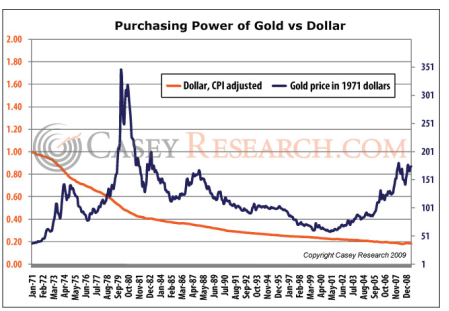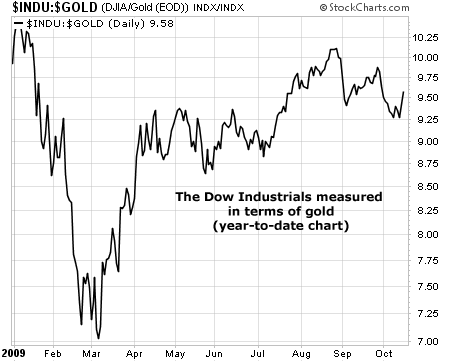| Home | About Us | Resources | Archive | Free Reports | Market Window |
The Only Sure Thing We Know About Gold and the U.S. DollarBy
Saturday, October 17, 2009
In August, the U.S. dollar celebrated its 38th anniversary as a fiat currency.
When Roosevelt issued his infamous 1933 presidential diktat, forcing delivery (confiscation) of gold owned by private citizens to the government in exchange for compensation, gold was $20.67 per ounce. In January 1934, the price was raised to $35 per ounce. The U.S. government pocketed the difference – and essentially devalued the dollar by 69%. Yet the dollar remained convertible, and foreign central banks could redeem their dollar reserves for gold. This presented no problem when the U.S. was running trade surpluses and foreigners didn't have many dollars to exchange for gold. But in 1965, France's President Charles de Gaulle started aggressively exchanging his country's dollars for gold and loudly encouraged other countries to do likewise. That year, U.S. gold holdings fell to a 26-year low. Several schemes were tried to stop the drain on the U.S.'s hoard, including lifting the price to $42 per ounce early in 1971, but nothing worked. The run on the dollar did not abate. With the U.S. unable to eliminate its trade deficit, Nixon was faced with the stark reality of another dollar devaluation. He opted instead to close the gold window on August 15, 1971, ending dollar-for-gold convertibility. The dollar was suddenly off the gold standard, and half of U.S. gold holdings had disappeared. The greenback began to "float," meaning it wasn't tied to any standard and could be printed at will. So how's it done since then? The following chart tracks what has happened to the purchasing power of the dollar and gold since the gold standard ended in 1971. After adjusting for inflation, you can plainly see the erosion of a dollar bill, now able to purchase only 18 cents of what it did in 1971, vs. an ounce of gold, which has not only stood up but increased in purchasing power.  There are two overriding conclusions from this chart:
At Casey Research, we believe the dollar must go lower over the coming years. Since the end of August 2008, the past year, the U.S. monetary base (coins, paper money, and central bank reserves) has swelled from about $800 billion to $1.7 trillion. This is the largest expansion in history and a staggering devaluation of the dollar.
And as you already know, we're also taking on unprecedented amounts of debt. Year-to-date government spending is $2.9 trillion, while tax revenue is only $1.6 trillion. But that's nothing compared to the massive unfunded liabilities (meaning, they are not covered by an asset of equal or greater value) of Medicare, Medicaid, Social Security, and prescription drugs. Liabilities from this trio total $105.7 trillion. Taking on debt is like getting a tattoo: It doesn't go away, and it's pretty painful to get rid of. The only way the U.S. government can get rid of its tattoos is by paying them off with greatly diluted dollars. There are a lot of uncertainties about how this situation will play out. But the future purchasing power of gold is not one of them. Regards, Jeff Clark Casey Research P.S. Gold can indeed give you solid returns, especially in times of crisis like these, when people start flocking to it as an uncertainty hedge. But select gold and silver stocks can gain even more with gold's run-up – so far, we've seen up to 6:1 leverage from large-cap gold producers. One company in particular has provided steady gains even as the Dow and S&P tanked last year; that's why we call it "48 Karat Gold." Click here to learn more.
Further Reading:
The Best Currencies for Diversifying Your Savings Market NotesGET REAL AMERICA
|
In The Daily Crux
Recent Articles
|


